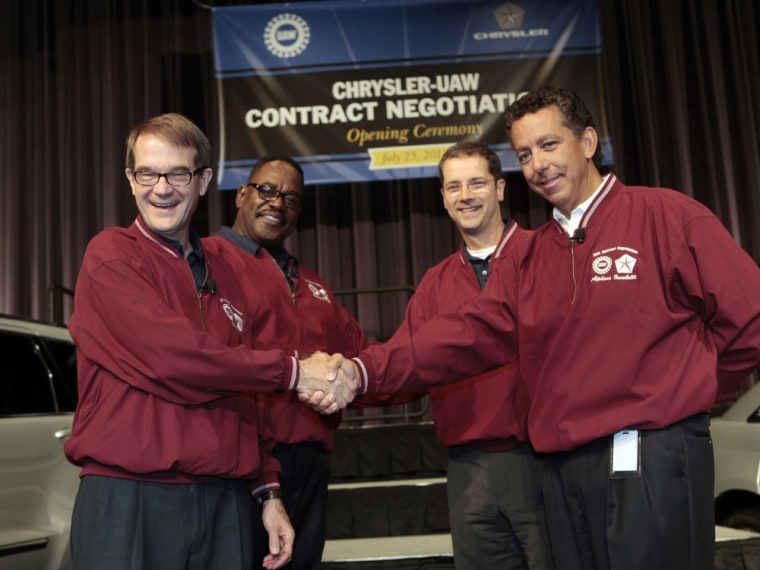UAW President Bob King has a notorious aversion to wearing ties. But his choice of garb was particularly significant when the labor veteran and his union bargaining team met with their counterparts from Chrysler Monday to begin contract talks covering 23,000 hourly workers. Both sides, in what they described as a show of solidarity, walked out in matching maroon jackets.
There’s no question that the contract talks kicking off this week between the United Auto Workers Union and Detroit’s Big Three automakers are different from past years. Both sides recognize that the domestic makers are still struggling to right themselves after the worst industry downturn since the Great Depression. But the future of the UAW is on the line too.
King and his team will be bicycling from Chrysler to General Motors to Ford this week for the ceremonial grip-and-grin photo ops. Behind the scenes, union and management teams have been quietly meeting for months to work on the key issues that they hope to resolve before the contract deadline in mid-September.
"We collectively feel we have a huge responsibility to the American public," said King, referring to the billions of taxpayer dollars that were spent bailing out GM and Chrysler.
Now more than ever before, labor and management are operating as if they have a common goal, according to many involved in the talks.
The 2009 bankruptcies of General Motors and Chrysler drove home the reality that the Big Three Detroit automakers could vanish if they fail to address fundamental issues that pushed the makers deep into debt and, over the decades, steadily eroded their sales and market share.
“We have to be competitive,” said Mark Fields, president of Ford of the Americas. The U.S. maker was the only one of the Big Three to avoid filing for bankruptcy protection two years ago, but unlike its crosstown rivals, it took on significant debt that it is desperate to draw down. So Ford is expected to seek additional concessions on top of what it has gotten since 2007, when the last round of contract talks was held.
Ford estimates it is spending about $58 an hour on wages and benefits for each unionized worker. Chrysler says the figure is closer to $52. That is about equal to what Chrysler officials believe its import rivals are paying at the many so-called “transplant” assembly lines that have sprung up across the country over the last quarter-century. The presence of those factories will be felt as the bargaining in Detroit moves forward.
“We’re out of the game of leading (the industry’s) labor costs,” said one well-placed source briefed on the negotiations at Chrysler. As recently as 2006, the domestics were paying about $76 an hour for UAW labor, which the source said was “unsustainable.” The source asked not to be named because the negotiations are ongoing.
While many UAW members would like to win back some of the concessions made in 2007 and 2009, union leaders are making relatively little noise about getting wage or benefit hikes this year. The bargaining is more likely to focus on where to allocate a fixed “bucket” of cash, perhaps by trimming health care costs to put a few more dollars in wage envelopes, the source said.
Enhanced profit-sharing
If there is to be more money, the UAW has signaled it will seek it in the form of enhanced profit-sharing programs. “Our members deserve more of the upside” when times are good, King said recently.
There’s another reason why this year’s talks will be different than in the past. The federal government barred the UAW from striking when it approved the GM and Chrysler bailouts two years ago. While a strike is possible at Ford, there hasn’t been one there in a third of a century. Instead, a deadlock would result in binding arbitration.
And that, King said, is not on his agenda at Chrysler. "If arbitration happens, if anything like that happens, then I'd say we haven't done our job.”
One of the few issues that could be a sticking point concerns the two-tier wage structure the UAW approved in 2007. King has fretted that those now being hired at half the pay aren’t getting a “living wage.” On the other hand, he has also acknowledged that the lower scale is encouraging Detroit's automakers to add jobs.
GM is building the new Chevrolet Sonic subcompact in a suburban Detroit plant, rather than importing it from Korea, as it did with the previous model, the Chevy Aveo. The Chrysler source, said the maker is studying 300 different plans to bring back work that it previously had outsourced to save money.
Even with recent expansions at plants in Sterling Heights, Mich., and Detroit, Chrysler has barely a third the number of UAW workers that it employed a decade ago. Total UAW membership, the union revealed, was 376,612 at the end of 2010, down from the 1979 peak of 1.53 million.
“That’s not sustainable,” warned Harley Shaiken, a former UAW member and now a labor professor at the University of California, Berkley.
One of the challenges facing the UAW will be to craft a contract that not only keeps the Detroit makers competitive but which also can help the union meet its next pressing goal: organizing the transplants. So far, only three have approved UAW representations and one, the former GM/Toyota joint venture near San Francisco, has closed.
UAW organizers have come to recognize that shows of strength won’t win the transplants, where workers are typically looking for stable jobs. Instead, the pitch will need to be what King calls “creative problem solving,” and the ability to deliver better pay and benefits than workers can win on their own.
So, what happens in Detroit over the next month-and-a-half could determine not only what goes into the pocket of Big Three union workers but whether they have a viable union to belong to.
